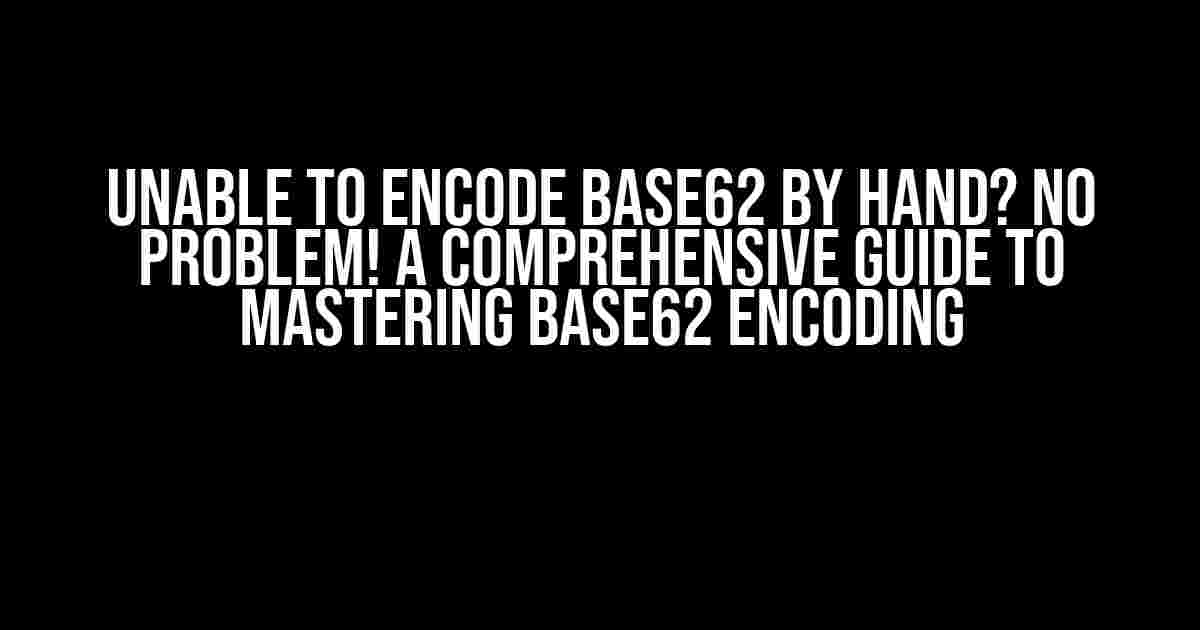Base62 encoding, a seemingly simple concept, yet many of us struggle to grasp it. You’re not alone if you’re scratching your head, wondering how to encode Base62 by hand. Fear not, dear reader, for this article is here to guide you through the process with ease. By the end of this comprehensive guide, you’ll be a Base62 encoding master, decoding and encoding with confidence!
What is Base62 Encoding?
Before we dive into the nitty-gritty of encoding Base62 by hand, let’s take a step back and understand what Base62 encoding is. Base62 encoding is a way to represent binary data (a series of 0s and 1s) using a set of 62 printable characters. These characters include:
- Uppercase letters (A-Z)
- Lowercase letters (a-z)
- Digits (0-9)
This encoding scheme is often used in various applications, such as:
- URL shortening services (e.g., bit.ly)
- Data storage and compression
- Cryptographic algorithms
The Math Behind Base62 Encoding
To understand how to encode Base62 by hand, we need to grasp the underlying math. Don’t worry; it’s not as complicated as it sounds!
In Base62 encoding, each character represents a value between 0 and 61. We can think of this as a base-62 number system. To encode a binary string, we’ll convert it into its decimal equivalent, then divide it by 62 to get the remainder and quotient.
Binary String: 10101011 Decimal Equivalent: 169 (2^7 + 2^4 + 2^3 + 2^2 + 2^1 + 2^0)
We’ll then use the quotient and remainder to determine the first Base62 character:
Quotient: 169 / 62 = 2 (integer division) Remainder: 169 % 62 = 45
The remainder, 45, corresponds to the 46th character in the Base62 alphabet (since indexing starts at 0). In this case, the character is ‘z’. We’ll repeat this process until the quotient becomes 0.
Step-by-Step Guide to Encoding Base62 by Hand
Now that we’ve covered the basics, let’s walk through a step-by-step example to encode a binary string to Base62:
-
Start with a binary string:
10101011 -
Convert the binary string to its decimal equivalent:
169 -
Divide the decimal number by 62 to get the quotient and remainder:
Quotient: 169 / 62 = 2 Remainder: 169 % 62 = 45 -
Use the remainder to find the corresponding Base62 character:
Remainder Base62 Character 45 z -
Repeat steps 3-4 until the quotient becomes 0:
Quotient: 2 / 62 = 0 Remainder: 2 % 62 = 2Remainder Base62 Character 2 c -
The final Base62 encoded string is:
zc
Common Pitfalls and Troubleshooting
Even with a solid understanding of the process, you might encounter some common issues. Let’s address a few:
-
Incorrect character mapping: Double-check that you’re using the correct Base62 alphabet and character mapping. A single mistake can lead to incorrect encoding.
-
Division errors: Make sure to perform integer division (floor division) to get the correct quotient and remainder.
-
Overflow errors: Be mindful of the maximum value that can be represented by a Base62 encoded string. If your input binary string is too long, you might exceed this limit.
Conclusion
And there you have it! With this comprehensive guide, you should now be able to encode Base62 by hand with confidence. Remember to practice, practice, practice to become proficient in this encoding scheme. If you’re still struggling, try working through more examples or referencing online resources.
Base62 encoding might seem complex at first, but with a solid understanding of the underlying math and a step-by-step approach, you’ll be encoding like a pro in no time. Happy encoding!
Frequently Asked Question
Having trouble encoding Base62 by hand? Don’t worry, we’ve got you covered! Here are some frequently asked questions and answers to help you out.
Why is Base62 encoding so confusing?
Base62 encoding can be confusing because it uses a combination of uppercase and lowercase letters, as well as numbers, to represent binary data. This unique alphabet of 62 characters can be tricky to work with, especially when trying to encode data by hand.
What’s the correct order of characters in the Base62 alphabet?
The correct order of characters in the Base62 alphabet is: 0-9, A-Z, a-z. This specific order is crucial when encoding data, so make sure to memorize it or keep it handy for reference!
How do I convert a binary number to Base62?
To convert a binary number to Base62, you need to divide the binary number into groups of 6 bits, then replace each group with the corresponding Base62 character. This process can be tedious, but there are also online tools and libraries that can make it easier for you!
Why do I need to pad my binary data with zeros when encoding to Base62?
You need to pad your binary data with zeros to ensure that the length of the data is a multiple of 6 bits. This padding is necessary because Base62 encoding works with groups of 6 bits, and any remaining bits need to be padded with zeros to avoid data loss.
Is there an easier way to encode Base62 instead of doing it by hand?
Yes, there are many online tools, libraries, and programming languages that can help you encode Base62 quickly and accurately. You can also use a Base62 encoder/decoder tool to simplify the process and avoid manual errors.
